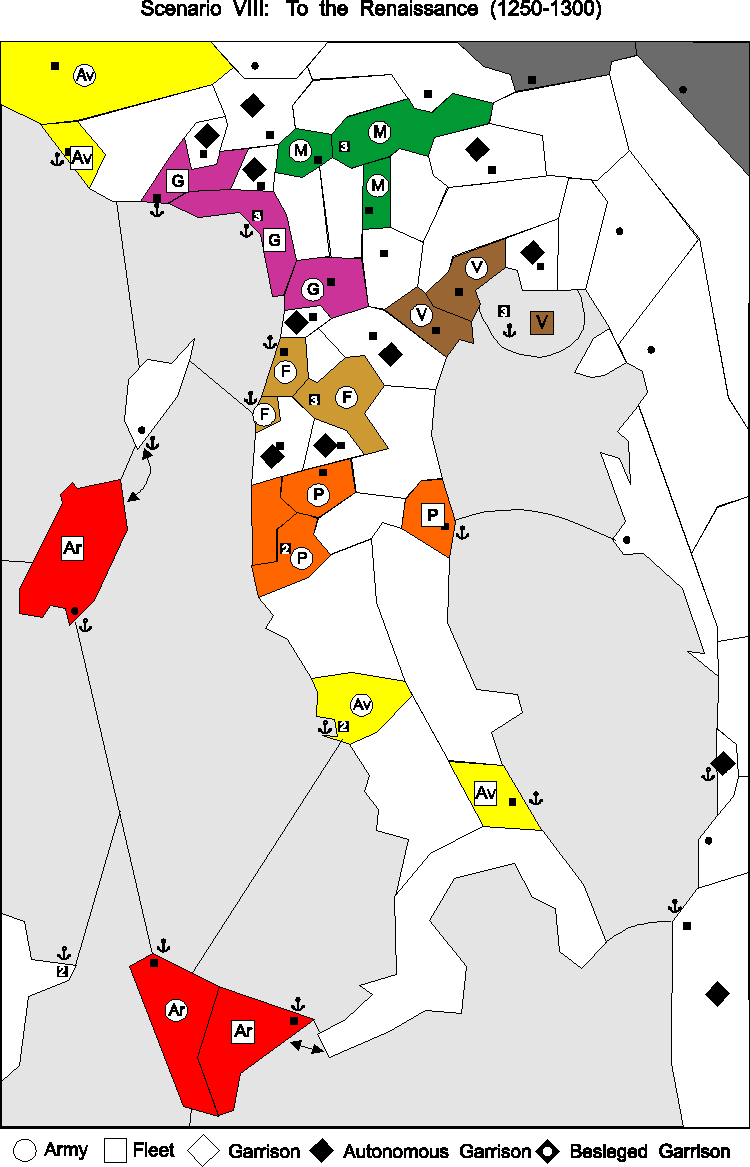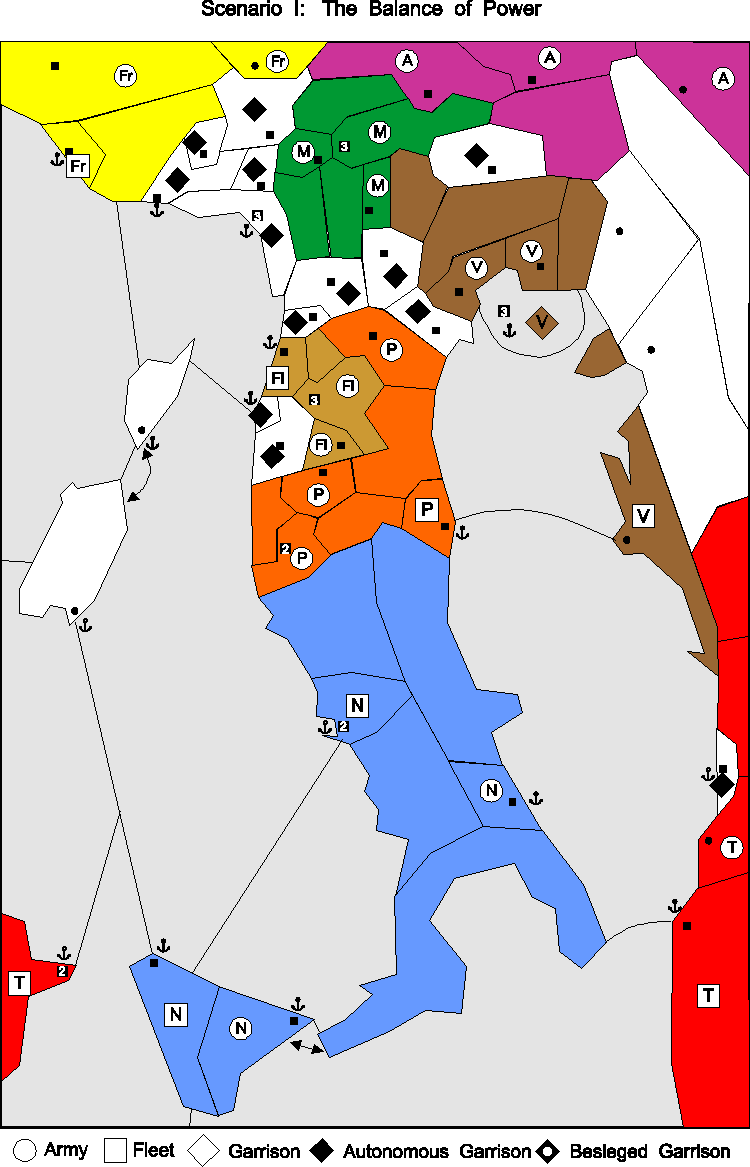
Below are the Machiavelli scenarios I have available for play. The first four come straight out of the rule book, while the second four scenarios are set in Medieval times and were originally published in Avalon Hill's now defunct The General
Scenario I: The Balance of Power
Scenario II: The Struggle for Dominance, Part One (1499-1521)
Scenario III: The Struggle for Dominance, Part Two (1513-1521)
Scenario IV: The Spanish Preponderance (1521-1529)
Scenario V: The Fall of the Lombards (725-800)
Scenario VI: Empire and Invaders (1051-1100)
Scenario VII: Papal Ascendancy and Mongol Threat (1177-1250)
Scenario VIII: To the Renaissance (1250-1300)
Scenario I: The Balance of Power
About the year 1454, the five major Italian powers, having reached a rough parity in strength, sought to create an anti-aggression peace alliance among themselves. The geopolitical situations had advanced a great deal since 1400. Many independent states had been absorbed, and five great states now dominated the political scene: Venice, Milan, Florence, Naples, and the Papal states. Venice was now a major land power, as well as retaining much of her sea empire and mercantile wealth. Florence had expanded and now was a sea power as well as a mercantile power. The Papacy had been restored to Rome, and under such dynamic Popes as Martin V, reasserted its sovereignty over the Papal States. With the resources and contributions of the faithful all over Europe, the restored, renewed, but now thoroughly secular Papacy was a force to be reckoned with. Milan, having failed in its bid to dominate the peninsula was still, under Francesco Sforza, one of the most powerful centralized Italian states. Finally, Naples, after being unified once again with Sicily by Alfonso of Aragon, was now a major maritime and land power. A new complicating factor was the interest in Italy by outside powers such as France and Austria, but especially by the Ottoman Turks. The Turks, unified and eager to expand, fresh from victory at Constantinople, were ready to move against Venice in the Balkans or Naples in southern Italy.
Start Date: Spring 1454
Setup
Austria: Hungary (A), Austria (A), Tyrolea (A), and Carinthia. Treasury: 1 ducat.
Florence: Arezzo (A), Florence (A), Pisa (F), and Pistoia. Treasury: 6 ducats/
France: Swiss (A), Avignon (A), Marseilles (F), and Provence. Treasury: 2 ducats.
Milan: Pavia (A), Cremona (A), Milan (A), Como, Fornova, and Parma. Treasury: 6 ducats.
Naples: Bari (A), Naples (F), Messina (A), Palermo (F), Otranto, Salerno, Aquila, and Capua. Treasury: 4 ducats.
Papacy: Bologna (A), Ancona (F), Perugia (A), Rome (A), Patrimony, Spoleto, and Urbino. Treasury: 4 ducats.
Turks: Albania (A), Durazzo (F), Tunis (F), Herzegovina, and Bosnia. Treasury: 4 ducats.
Venice: Padua (A), Treviso (A), Venice (G), Dalmatia (F), Bergamo, Verona, Friuli, and Istria. Treasury: 9 ducats.
Autonomous Garrisons: One each in Turin, Savoy, Montferrat, Saluzzo, Genoa, Trent, Ferrara, Mantua, Modena, Lucca, Sienna, Piombino, and Ragusa.
Variable Income (Advanced)
A. The Papacy, Naples, Milan, France, Austria, and the Turks receive variable income as indicated on the chart.
B. Florence and Venice receive double the amount of variable income shown on the chart (e.g.: 6 instead of 3).
C. The player who occupies or control Genoa city receives variable income for it as shown on the chart.
Player Variants
Two Players: Treat Austria and France as neutrals. Each player takes three of the remaining powers at random.
Three Players: Treat Austria and France as neutrals. Each player randomly takes two of the remaining powers.
Four Players: Each player randomly takes two of the powers.
Five Players: Treat the Turks, Austria, and France as neutrals. Each player takes one of the remaining powers.
Six Players: Treat Austria and France as neutrals. Each player randomly takes one of the remaining powers.
Seven Players: Treat Austria as neutral. Each player randomly takes one of the remaining powers.
Eight Players: Each player randomly takes one power.

Scenario II: The Struggle for Dominance, Part One (1499-1521)
This period covers the era from the invasion by Louis XII of France in 1499 to the betrayal of the French-controlled Milan to Charles V of Austria in 1521. This was a very confused era of almost continual warfare touched off by the French invasion which led to the downfall of Ludovico il Moro, Duke of Milan, and the French possession of Milan for 19 of the next 21 years. This period also saw increasing Spanish and Austrian involvement in Italian affairs. First the Austrians under Maximillian faced the French in Milan, the the Aragonese (Spain) under the cynical Ferdinand entered the affairs of Sicily and Naples, and finally the Emperor Charles V, ruler of both Spain and Austria, moved to expel the French from Milan. The different Italian states played a variety of roles during this period. Florence, embarrassed by internal difficulties, normally found itself allied with the French against the Papal States and Naples. Venice survived an attack by all the other states in 1509, only to see much of its mercantile empire swept away by the aggressive Turks. The Papacy, hoping to remove the French influence from the Peninsula, restored the exiled Medici as rulers of Florence and threw its weight into the balance in Spain's favor. Milan, occupied by France almost the whole time, played no independent role.
Start Date: Spring 1499
Setup
Austria: Austria (A), Tyrolea (A), Swiss (A), Sardinia (F), Palermo (F), Messina (A), Hungary, and Carinthia. Treasury: 0 ducats.
Florence: Arezzo (A), Florence (A), Pisa (F), and Pistoia. Treasury: 6 ducats.
France: Avignon (A), Marseilles (F), Saluzzo (A), Milan (A), Genoa (F), Naples (A), Bari (A), and Provence. Treasury: 11 ducats.
Papacy: Bologna (A), Ancona (F), Perugia (A), Rome (A), Patrimony, Spoleto, and Urbino. Treasury: 4 ducats.
Turks: Albania (A), Durazzo (F), Tunis (F), Herzegovina, and Bosnia. Treasury: 4 ducats.
Venice: Padua (A), Treviso (A), Venice (G), Dalmatia (F), Bergamo, Verona, Friuli, and Istria. Treasury: 9 ducats.
Autonomous Garrisons: One each in Turin, Savoy, Montferrat, Pavia, Cremona, Trent, Ferrara, Mantua, Modena, Lucca, Sienna, Piombino, and Ragusa.
Special Rule: Milan, Genoa, Naples, Bari, and Saluzzo are not part of the French home country (use regular control markers), and new military units may not be placed there.
Variable Income (Advanced)
A. The Papacy, France, Austria, and the Turks receive variable income as indicated on the chart.
B. Florence and Venice receive double the amount of variable income shown on the chart (e.g.: 6 instead of 3).
C. The player(s) who occupies or control Genoa, Naples, or Milan receives variable income for each of those as shown on the chart.
Player Variants
Two Players: Treat the Turks as neutral. One player takes France and Venice; the other player takes the remaining three
Three Players: Treat the Turks as neutral. One player takes France, one player takes Austria and the Papacy, and the third players takes Venice and Florence.
Four Players: One player takes France, one player takes Venice and the Turks, one player takes Austria, and the fourth player takes Florence and the Papacy.
Five Players: Treat the Turks as neutral. Each player takes one of the remaining powers at random.
Six Players: Each player randomly takes one power.
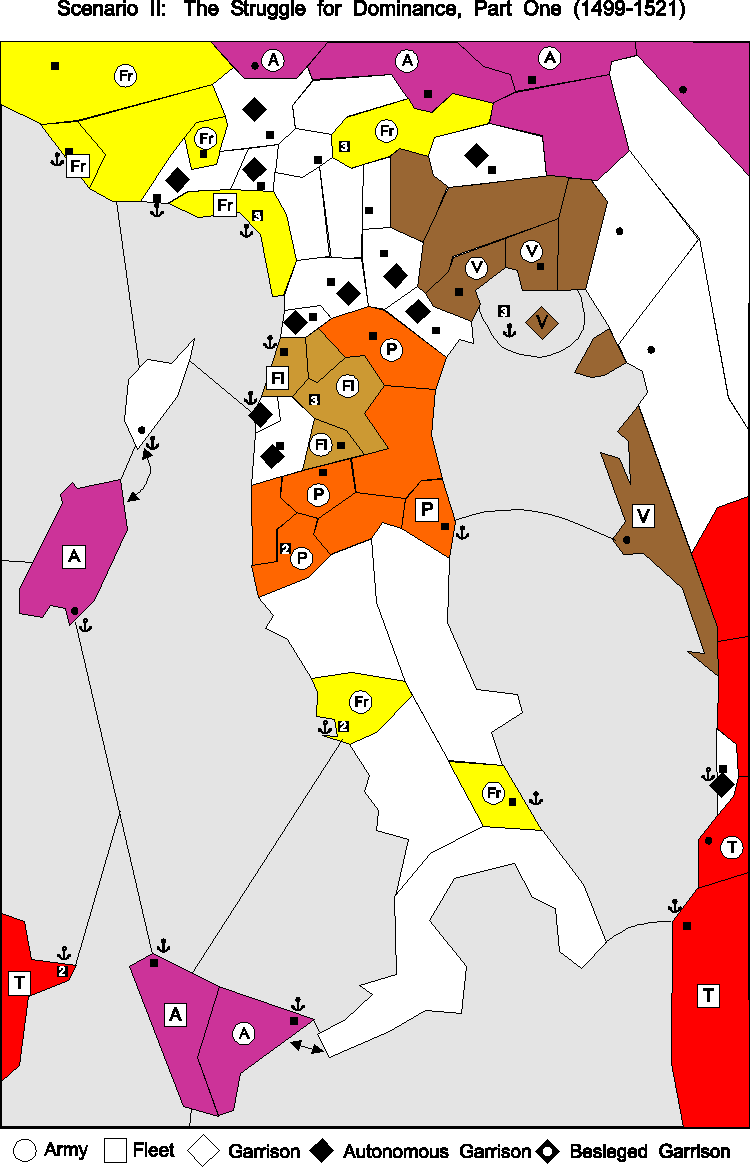
Scenario III: The Struggle for Dominance, Part Two (1513-1521)
The situation in 1513 is very confused and interesting. The French had been thrown out of most of Italy and Maximillian Sforza (represented by Milanese units) was allied with the Swiss and the D'Este family in Modena and Ferrara.
Start Date: Spring 1513
Setup
Austria: Austria (A), Tyrolea (A), Milan (A)*, Sardinia (F), Messina (A), Naples (F), Bari (A), Carinthia, Capua, Aquila, Salerno, Otranto, and Palermo. Treasury: 5 ducats.
France: Avignon (A), Marseilles (F), Saluzzo (A), Milan (G)*, and Provence. Treasury: 2 ducats.
Milan: Pavia (A), Cremona (A), Modena (A), Ferrara (A), and Swiss. Treasury: 2 ducats.
Papacy: Bologna (A), Ancona (F), Perugia (A), Rome (A), Patrimony, Spoleto, and Urbino. Treasury: 4 ducats.
Turks: Albania (A), Durazzo (F), Tunis (F), Hungary (A), Herzegovina, and Bosnia. Treasury: 4 ducats.
Venice: Padua (A), Treviso (A), Venice (G), Dalmatia (F), Bergamo, Verona, Friuli, and Istria. Treasury: 9 ducats.
Autonomous Garrisons: One each in Turin, Savoy, Montferrat, Genoa, Trent, Mantua, Lucca, Pisa, Florence, Arezzo, Sienna, Piombino, and Ragusa.
*Note: There are two military units in Milan -- one is in the city and the other is in the province. Neither player has a control marker there. Milan is not part of anybody's home country, and new military units may not be placed there.
Variable Income (Advanced)
A. The Papacy, France, Austria, Milan, and the Turks receive variable income as indicated on the chart.
B. Venice receives double the amount of variable income shown on the chart (e.g.: 6 instead of 3).
C. The player(s) who occupies or control Genoa, Naples, or Florence receives variable income for each of those as shown on the chart.
Player Variants
Four Players: One player takes France and the Turks, one player takes Milan and the Papacy, one player takes Austria, and the fourth player takes Venice.
Five Players: One player takes France and the Turks; the other players take one of the remaining powers
Six Players: Each player randomly takes one power.
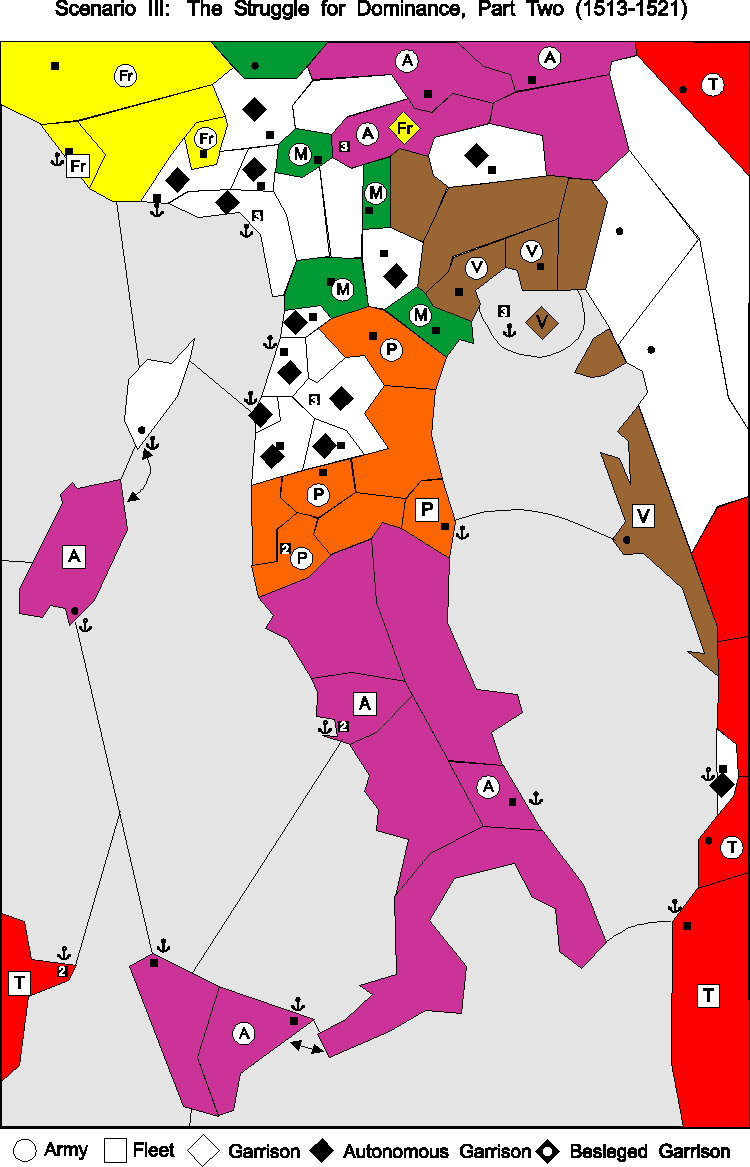
Scenario IV: The Spanish Preponderance (1521-1529)
During the later stages of the Italian Wars, the power balance situation was completely changed from earlier periods. The French had lost their hold on Milan and Genoa. Spain (linked with Naples) and Austria, both ruled by the Hapsburg Emperor Charles V, had gained Milan, and threatened to dominate both Northern and Southern Italy. As usual, the Italian states took various positions in the struggle. Venice was menaced by the Turks, and had to devote most of its attention to its Balkan empire. Florence allied with France to avoid becoming a vassal of Spain and the Papacy. The Turks were stronger, conquering Hungary and threatening to overrun the Balkans and Southern Italy.
Start Date: Spring 1521
Setup
Austria: Austria (A), Tyrolea (A), Milan (A), Sardinia (F), Messina (A), Naples (A), Bari (A), Palermo (F), Carniola (A), Carinthia, Capua, Aquila, Salerno, and Otranto. Treasury: 4 ducats.
Florence: Arezzo (A), Florence (A), Pisa (F), and Pistoia. Treasury: 3 ducats.
France: Avignon (A), Marseilles (F), Saluzzo (A), Swiss (A), and Provence. Treasury: 1 ducat.
Papacy: Bologna (A), Ancona (F), Perugia (A), Rome (A), Patrimony, Spoleto, and Urbino. Treasury: 4 ducats.
Turks: Albania (A), Durazzo (F), Tunis (F), Hungary (A), Herzegovina, and Bosnia. Treasury: 3 ducats.
Venice: Padua (A), Treviso (A), Venice (F), Dalmatia (F), Bergamo, Verona, Friuli, and Istria. Treasury: 6 ducats.
Autonomous Garrisons: One each in Turin, Savoy, Montferrat, Genoa, Pavia, Cremona, Trent, Mantua, Ferrara, Modena, Lucca, Sienna, Piombino, and Ragusa.
Variable Income (Advanced)
A. All powers (Austria, France, Turks, Florence, Venice, and the Papacy) receive variable income as indicated on the chart.
B. The player(s) who occupies or control Genoa or Naples city receives variable income for each of those as shown on the chart.
Player Variants
Two Players: Drop Florence from the game and replace its military units with Autonomous Garrisons. One player takes France and the Turks, and the other player takes Austria. Both players then take any one of the remaining powers at random.
Three Players: One player takes Austria; anther player takes France, the Turks, and Florence, and the third player takes Venice and the Papacy.
Four Players: One player takes Austria; another player takes France and the Turks; another player takes Venice and the Papacy; the fourth player takes Florence with the addition of Genoa, where a Florentine fleet will replace the Autonomous garrison. (Genoa is controlled but not part of the home country.) The Florentine player also gets 4 more ducats for his starting treasury (total of 7).
Five Players: One player takes France and Florence; the other players take one of the remaining powers
Six Players: Each player randomly takes one power.
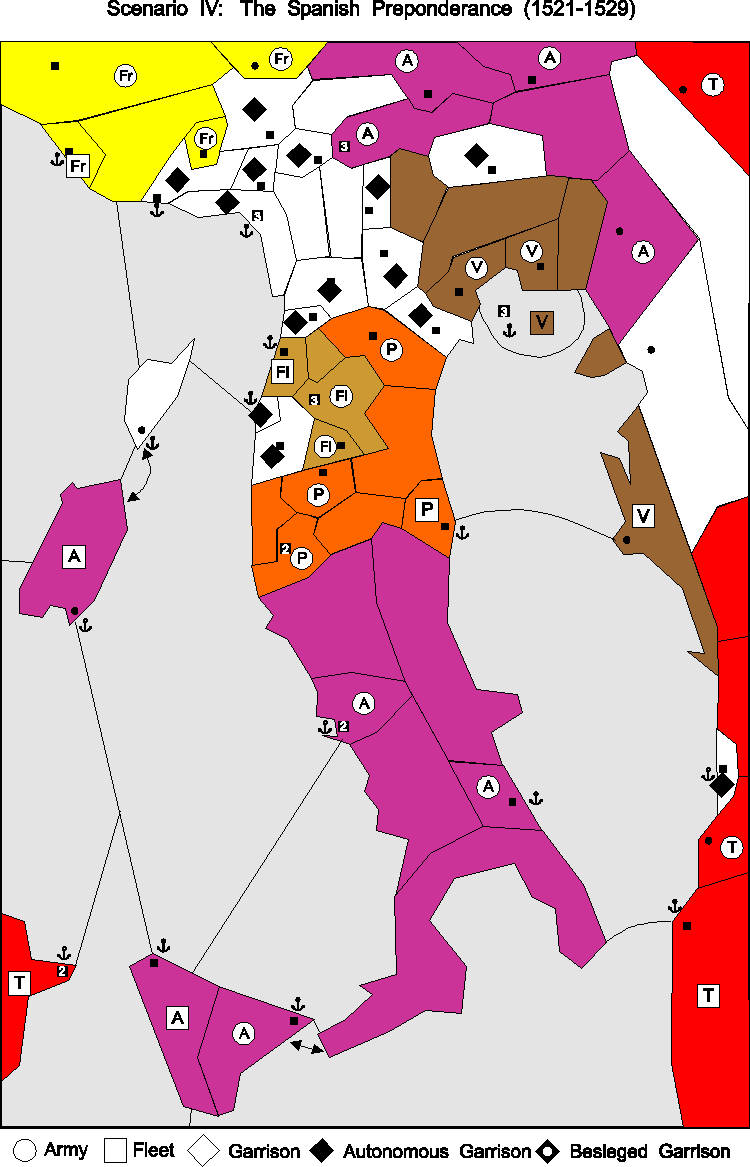
Scenario V: The Fall of the Lombards (725-800)
Although the Byzantine Empire under the generalship of Narses expelled the last of the Ostrogoth invaders from Italy 554, external pressures on the Roman world -- both from the east and from the west -- proved too much for the Empire to maintain its traditional borders. With the death of Narses, new Germanic tribesmen, the Lombards, pushed through the Alps onto the northern Italian plains. By 600, the Lombards controlled most of Italy, including the Po River Valley, Tuscany, and a large area south of Rome. The Byzantines kept only toeholds in Sicily, around their capital in Ravenna and in southern Italy. The Papal See, however, retained considerable military power at Rome and its precincts.
The Popes viewed the Lombards as both potential allies and future enemies. At first, the Papacy courted the Lombards' military strength in the hope of gaining control of Byzantium's holdings in central Italy. In collusion with Papal authorities, the Lombards at first successfully challenged the Empire. In 751, they succeeded in capturing Ravenna and in driving the Byzantines permanently from the area. Fearing now that they had created in the Lombards an enemy more dangerous than the Byzantines, the Papacy turned to France to thwart their power. Under Pepin in the 750's and then under Charlemagne in the 770's, the Frankish Empire, at the urging of the Papacy, invaded Italy, destroyed the Lombard hegemony in northern Italy, and turned over the former Byzantine area in central Italy to Rome. After their defeat, the Lombards held tenuously only to a group of declining possessions in southern Italy.
Start Date: Spring 725
Setup
Byzantines (use Venetian units): Palermo, Messina (A), Otranto, Durazzo (F), Albania (F), Ragusa (F), Dalmatia (F), Friuli (A), Treviso (A), Padua (A), and Ferrara (A). Treasury: 4 ducats.
France: Avignon (A), Marseilles (F), Swiss (A), Savoy (F), Saluzzo (A), and Provence. Treasury: 2 ducats.
Lombards (use Austrian units): Turin (A), Pavia (A), Modena (A), Mantua (A), Cremona (A), Naples (A), Bari (A), and Aquila. Treasury: 6 ducats.
Papacy: Rome (A), Patrimony, Ancona (F), Perugia (A), Arezzo (A), and Urbino. Treasury: 6 ducats.
Autonomous Garrisons: One each in Tunis, Sienna, Piombino, Pisa, Florence, Bologna, Lucca, Genoa, Montferrat, Milan, and Venice.
Neutral Provinces: Tyrolea, Austria, and Hungary.
Variable Income (Advanced)
A. The Papacy and France receive variable income as indicated on the chart.
B. The Lombard player receives the variable income indicated for Venice on the chart, but does not need to control Venice to receive the income. No other player may receive the variable income for Venice.
C. The Byzantine player receives the variable income indicated for the Turks.
Special Rule: The Lombards may never build fleets or convert military units into fleets. Their army units, however, may be convoyed by other powers per normal convoy rules.
Player Variants
Two Players: One player takes France and the Papacy, the other player takes the Byzantines. All Lombard units are considered to be inactive.
Three Players: One player takes France and the Papacy, one player takes the Lombards, and one player takes the Byzantines.
Four Players: Each player takes one of the powers.
Special Units (Optional Rule)
Citizen Militia units are not available.
Elite Mercenary units are available to all powers.
Elite Professional units are available to the Byzantines only.
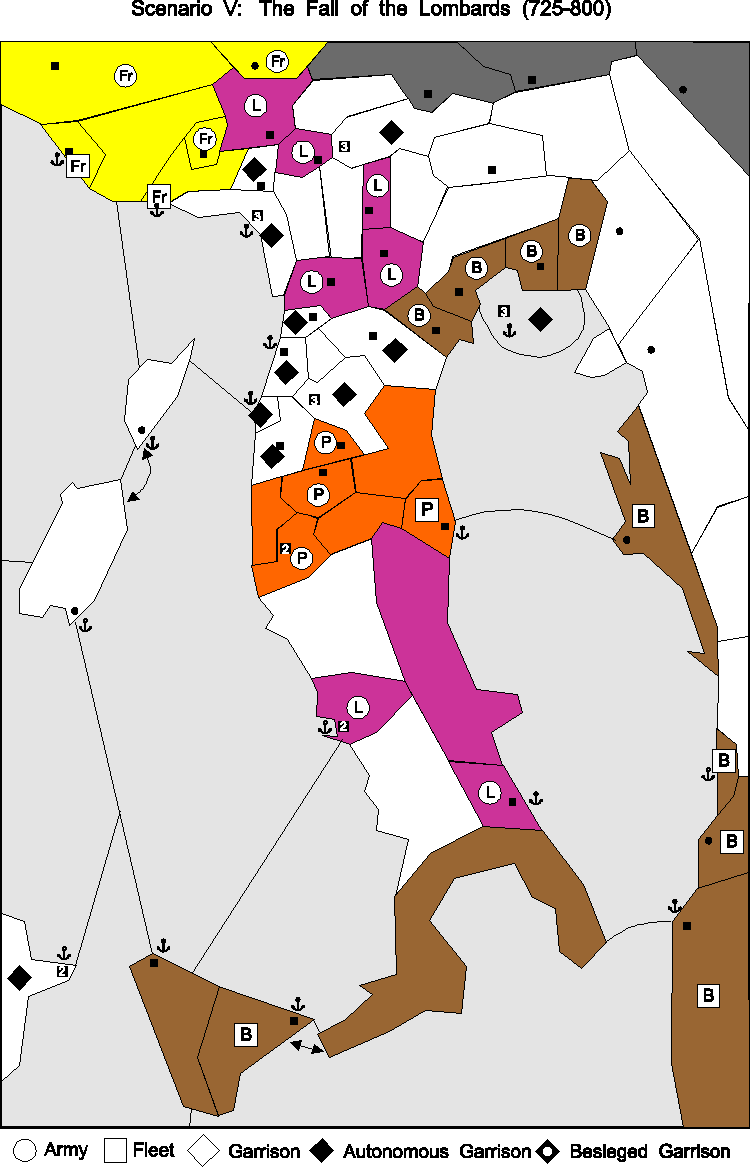
Scenario VI: Empire and Invaders (1051-1100)
By the beginning of the new millennium, the Holy Roman Empire under Otto I had succeeded both in invading northern Italy and in establishing control of the area. In return for Otto's promise to recognize Papal power over central Italy, the Pope agreed to crown him Emperor. Otto, however, counterclaimed the right to confirm Papal elections. Thus were sown the seeds of conflict between the Empire and Papacy concerning the exercise of competing spiritual and temporal powers. The conflict was to last for centuries. Under Imperial rule, northern Italy divided into two rival camps: the Guelphs (pro-Papal) and the Ghibellines (pro-Empire). All during the period, however, despite the theoretical allegiance to the Emperor, northern Italian cities (especially Pisa and Venice) developed autonomously as small, but powerful, city states.
In the south, the Duchy of Benevento (a remnant of the original Lombard Kingdom) conducted a desultory war with Byzantium. The conflict succeeded only in weakening both sides. Thus, when the Normans under Robert Guiscard invaded the area in the second half of the eleventh century, they met with little organized resistance. By 1071, both Lombard and Byzantine power had been effectively wiped out. The Normans were pro-Papal, and their military might and able administration greatly increased the prestige of the Papal See to the detriment of the Empire. Toward the end of the century, Robert's brother Roger extended Norman control in the Mediterranean with a successful invasion of Sicily, seizing it from the Muslims, who had themselves taken the island from the Eastern Roman Empire in 865.
Start Date: Spring 1051
Setup
Byzantines (use Milanese units): Salerno (A), Otranto (A), Ragusa (F), Albania, and Durazzo. Treasury: 6 ducats.
Holy Roman Empire (use Austrian units): Milan (A), Pavia (A), and Cremona (A). Treasury: 5 ducats.
Muslims (use Turkish units): Tunis, Central Mediterranean (F), Palermo (A), and Messina (A). Treasury: 6 ducats.
Normans (use Neapolitan units): Tyrrhenian Sea (F), Gulf of Naples (F), and Naples (A). Treasury: 4 ducats. Only Naples is considered a home province of the Normans.
Papacy: Rome (A), Patrimony, Perugia (A), and Arezzo (A). Treasury: 3 ducats.
Pisa (use Florentine units): Pisa (F), Lucca (A), and Piombino (A). Treasury: 4 ducats.
Venice: Venice (F), Padua (A), and Treviso (A). Treasury: 6 ducats.
Lombards (use French units): Ancona (A) and Bari (A)
Autonomous Garrisons: One each in Turin, Montferrat, Genoa, Trent, Mantua, Modena, Ferrara, Bologna, Florence, and Sienna.
Neutral Provinces: Avignon, Marseilles, Provence, Savoy, Saluzzo, Swiss, Tryolea, Austria, Hungary, and Slavonia
Variable Income (Advanced)
A. The Papacy and Venice receive variable income as indicated on the chart.
B. The Holy Roman Empire receives the variable income indicated for Austria on the chart.
C. The Byzantine player receives the variable income indicated for Milan, but does not need to control Milan to receive this income. No other power may receive the variable income for Milan.
D. The Muslims receive the variable income indicated for the Turks.
E. The Pisan player receives the variable income indicated for Florence, but does not need to control Florence to receive this income. No other power may receive the variable income for Florence.
F. The Normans receive the variable income indicated for France.
Victory Conditions
Games with Five or More Players: The winner is the first player to control at least 12 cities (fortified or unfortified) at the start of a spring turn.
Games with Four or Fewer Players: The winner is the first player to control at least 15 cities (fortified or unfortified) at the start of a spring turn.
Special Rules
1. The Holy Roman Empire may never build fleets or convert military units to fleets. Their army units, however, may be convoyed by other powers per the normal convoy rules.
2. The Normans are slated to receive more military units at the beginning of the game than they have cities to support them. If they do not control sufficient cities to support the number of units they possess by the military unit adjustment phase of the next spring turn (1052), they must eliminate the extra units per the normal rule for unit removal (4.1). the Normans possess only one home province/city (Naples). However, as an exception to the normal rule of replacing new units (4.2)the Norman player can place new units in Naples and/or in any other Norman-controlled provinces/cities subject to the other restrictions of rule 4.2.
3. The two Lombard army units are considered to be inactive.
Player Variants
Two Players: The Muslims, Pisa, and the Holy Roman Empire are considered inactive. One player takes the Papacy and Venice, the other player takes the Byzantines and the Normans.
Three Players: The Muslims are considered inactive. One player takes the Normans and the Byzantines, one player takes Rome and Pisa, and the third player takes the Holy Roman Empire and Venice.
Four Players: The Muslims, Pisa, and the Holy Roman Empire are considered inactive. Each player takes one of the remaining powers.
Five Players: The Muslims and Pisa are considered inactive. Each player takes one of the remaining powers.
Six Players: The Muslims are considered inactive. Each player takes any one of the remaining powers.
Seven Players: Each player takes one of the powers.
Special Units (Optional Rule)
Citizen Militia units are available to Florence and Venice.
Elite Mercenary units are available to all powers.
Elite Professional units are available to the Byzantine and Holy Roman Empire.
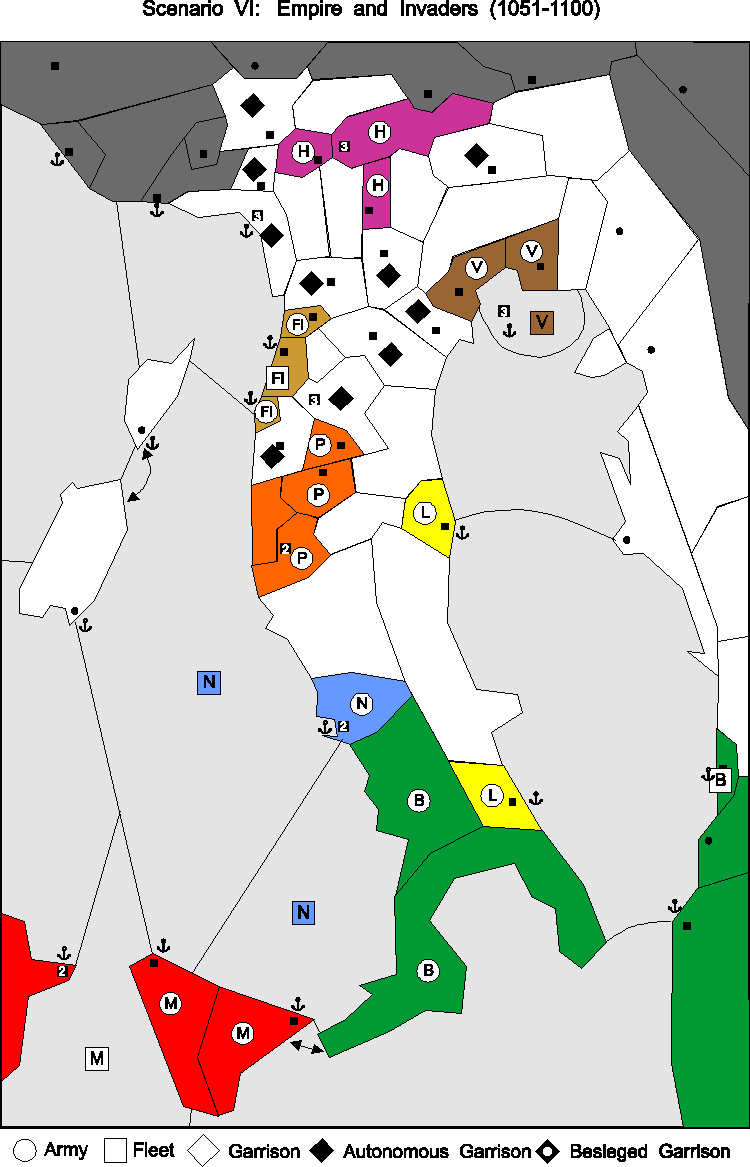
Scenario VII: Papal Ascendancy and Mongol Threat (1177-1250)
In 1176, the Holy Roman Empire's control of northern Italy was dealt a severe blow when the "Lombard League," under the leadership of Milan, defeated the Imperial army at the battle of Legnano. Then, when dynastic struggles erupted in Germany, the Papacy was able to strengthen its hold over the Papal States under the able leadership of Pope Innocent III. In the south, however, the Empire fared better. The marriage of Emperor Henry VI to Norman princess Constance of Sicily helped ensure the spread of Imperial influence to Naples and Palermo. In fact, their son, Frederick II, was to rule the Empire largely from Sicily.
During this time, while the fortunes of Byzantium declined, those of smaller kingdoms within its borders rose. This was especially true of Hungary and Serbia, which developed into small but powerful principalities. Venice, too, basking in its wealth as one of the dominant commercial powers of the Mediterranean, made good use of the increased trading opportunities engendered by the collapse of Byzantium and the rise of the Crusader States. However, the ever-present threat of Mongol invasion loomed over all of Europe. During this period, the Mongols swept through Asia, the Middle East, Russia and Central Europe, and seemed to be on the brink of crushing Vienna and Venice. It was only the fortuitous death of Ogodai Khan which caused the Mongol armies to retire to Asia, never again to threaten Europe.
Start Date: Spring 1177
Setup
Holy Roman Empire (use Neapolitan units): Messina (F), Palermo (A), Naples (F), and Bari (A). Treasury: 2 ducats.
Milan: Milan (A), Trent (A), Cremona (A), Mantua (A), and Modena (A). Treasury: 6 ducats.
Mongols (use Austrian units): Austria (A), Tyrolea (A), Hungary (A), Carniola (A), and Croatia (A). Treasury: 5 ducats.
Papacy: Rome (A), Patrimony, Perugia (A), Arezzo (A), Florence (A), and Pisa (F). Treasury: 4 ducats.
Venice: Venice (F), Dalmatia (F), Padua (A), Treviso (A), and Ferrara (A). Treasury: 6 ducats.
Autonomous Garrisons: One each in Turin, Montferrat, Genoa, Pavia, Lucca, Bologna, Sienna, Piombino, Ancona, Tunis, Ragusa, and Durazzo.
Neutral Provinces: Avignon, Marseilles, Provence, Savoy, Saluzzo, and Swiss.
Variable Income (Advanced)
A. The Papacy, Venice, and Milan receive variable income as indicated on the chart.
B. The Holy Roman Empire player receives the variable income indicated for Naples, but does not need to control Naples to receive this income. No other power may receive the variable income for Naples.
C. The Mongols receive the variable income indicated for Austria.
Victory Conditions
Games with Five Players: The winner is the first player to control at least 13 cities (fortified or unfortified) at the start of a spring turn.
Games with Four or Three Players: The winner is the first player to control at least 15 cities (fortified or unfortified) at the start of a spring turn.
Games with Two Players: The winner is the first player to control at least 18 cities (fortified or unfortified) at the start of a spring turn.
Special Rules: Mongol units are place on the board only in a five-player game. In games with fewer than five players, all beginning home provinces of the Mongol player (Tyrolea, Austria, Hungary, Carniola, and Croatia) are considered to be neutral provinces.
Player Variants
Two Players: One player takes the Papacy and the Holy Roman Empire, while the other player takes Milan and Venice.
Three Players: The Holy Rome Empire units are not placed on the board; their home provinces are considered neutral. Each player takes any one of the remaining powers.
Four Players: Each player takes any one power other than the Mongols.
Five Players: Each player takes one of the powers.
Special Units (Optional Rule)
Citizen Militia units are available to Milan, Venice, and the Mongols
Elite Mercenary units are available to all powers.
Elite Professional units are available to the Holy Roman Empire and Venice.
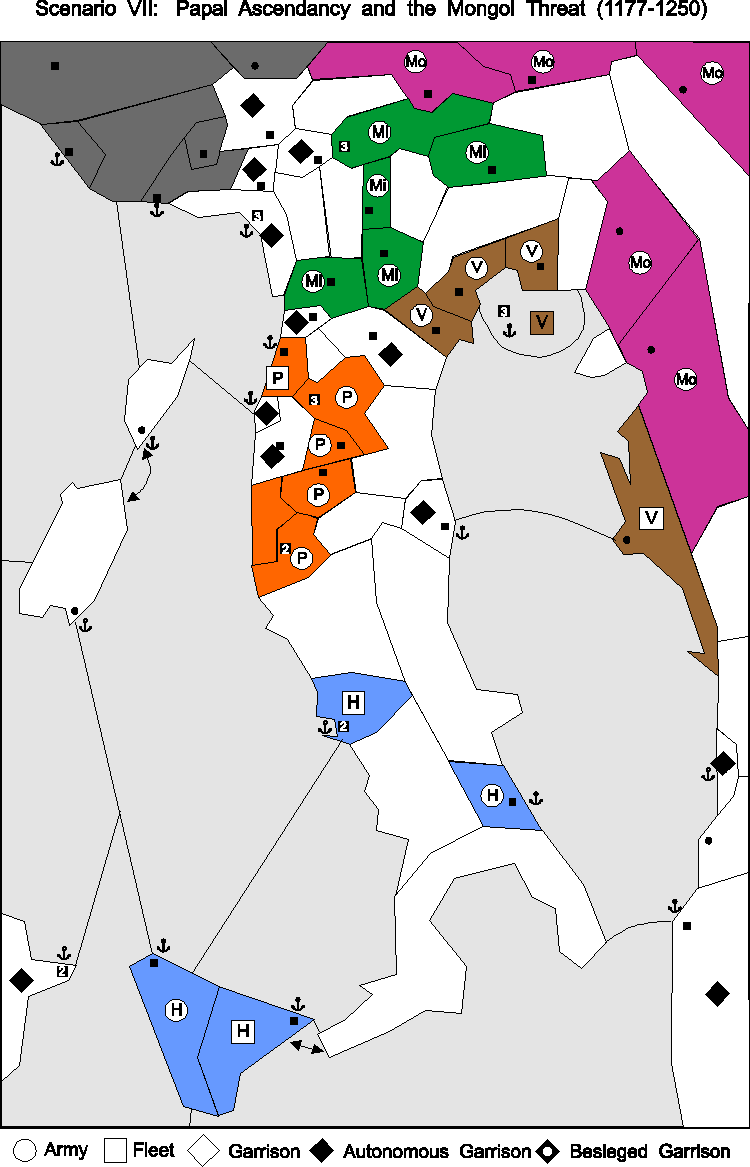
Scenario VIII: To the Renaissance (1250-1300)
As a result of both continual opposition by the Papacy and the rising influence of the Italian city states, the Holy Roman Empire's hold on northern Italy was virtually at an end. In the south too, the descendants of Frederick II found their power stripped from them by the active cooperation of Pope Urban IV and his French favorite, Charles of Anjou. Charles brought an army to southern Italy, defeated Frederick's son Manfred in battle, and seized what was left of Imperial power there, calling himself King of Naples. Deeply resenting French influence in their affairs, the Sicilians called upon Pedro III of Aragon (who was related to Frederick by marriage) for military assistance. Pedro defeated Charles and became King of Sicily. In the ensuing years Pedro's descendants extended the power of Aragon to include both Corsica and Sardinia. Thus, by the end of the century, southern Italy was divided between the French and the Spanish. The Holy Roman Empire had been effectively excluded from the Italian peninsula.
In the north, the trade rivalries between Venice and Genoa had led to open warfare. Genoa, in this period, gained the upper hand and reached the peak of its power and prestige. (It was at this time that Marco Polo, who had since returned from China, was captured by the Genoese and imprisoned.) Milan also grew in importance as the leading manufacturing center on the Lombard plain, while Florence on the other side of the Apennines began to acquire neighboring lands and to increase its military muscle. In a short period of time, Florence became the cultural capital of Europe and the birthplace of the Renaissance.
Start Date: Spring 1253
Setup
Aragon (use Turkish units): Palermo (A), Messina (F), and Sardinia (F). Treasury: 6 ducats.
Avignon (use French units): Avignon (A), Marseilles (F), Naples (A), and Bari (F). Treasury: 8 ducats.
Florence: Florence (A), Pisa (A), and Piombino (A). Treasury: 4 ducats.
Genoa (use Austrian units): Genoa (F), Savoy (F), and Modena (A). Treasury: 6 ducats.
Milan: Milan (A), Pavia (A), and Cremona (A). Treasury: 6 ducats.
Papacy: Rome (A), Patrimony, Perugia (A), and Ancona (F). Treasury: 4 ducats.
Venice: Venice (F), Padua (A), and Ferrara (A). Treasury: 6 ducats.
Autonomous Garrisons: One each in Turin, Montferrat, Saluzzo, Trent, Lucca, Bologna, Sienna, Arezzo, Treviso, Ragusa, and Durazzo.
Neutral Provinces: Austria and Hungary.
Variable Income (Advanced)
A. The Papacy, Venice, Florence, and Milan receive normal variable income as indicated on the chart.
B. Genoa receives the variable income indicated for Genoa, but does not need to control the city of Genoa to receive this income. No other power may receive the variable income for Genoa. The three ducats for the city of Genoa are collected by any power controlling the city as in the normal rules.
C. Aragon receives the variable income indicated for Austria.
D. Avignon receives the variable income indicated for Naples, but does not need to control Naples to receive this income. No other power may receive the variable income for Naples.
Player Variants
Two Players: Treat Avignon as inactive. One player takes Venice, Milan, and Genoa, while the second player takes the remaining three powers.
Three Players: Treat Avignon as inactive. One player takes the Papacy and Florence, one takes Venice and Milan, and the third takes Genoa and Aragon.
Four Players: Treat Avignon as inactive. One player takes the Papacy and Florence, one takes Genoa and Milan, one takes Aragon, and the fourth player takes Venice.
Five Players: Treat Avignon and Aragon as inactive. Each player takes any one of the remaining powers.
Six Players: Treat Avignon as inactive. Each player takes any one of the remaining powers.
Seven Players: Each player takes one of the powers.
Special Units (Optional Rule)
Citizen Militia units are available to Florence, Milan, Genoa, the Papacy, and Venice.
Elite Mercenary units are available to all powers.
Elite Professional units are available to Aragon, Avignon, Genoa, and Venice.
